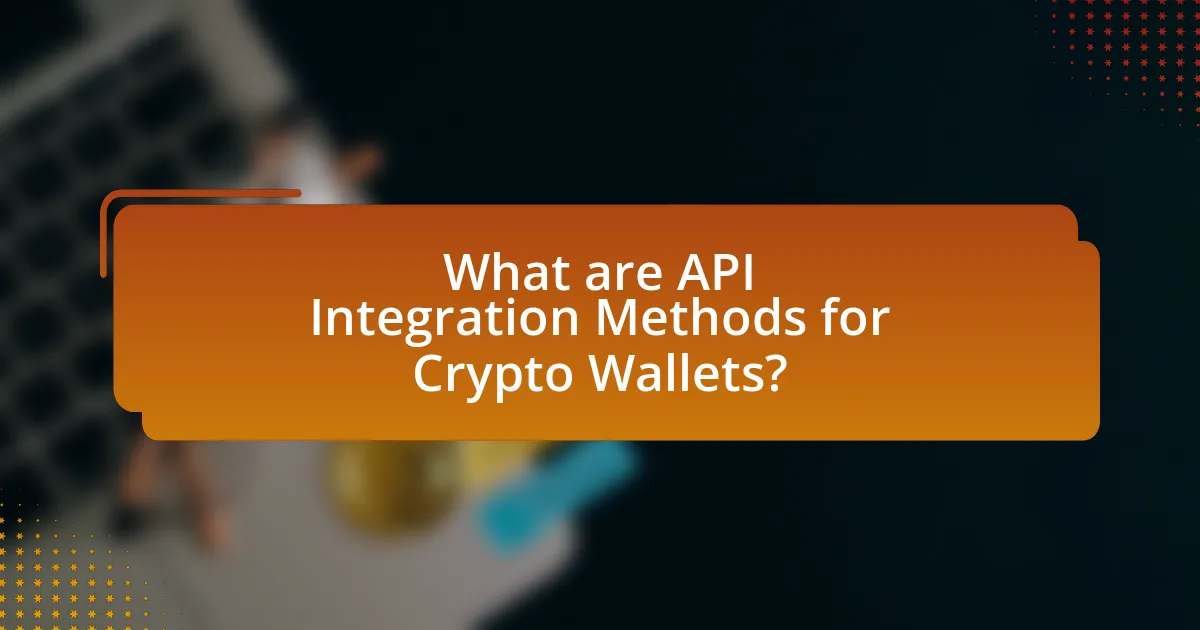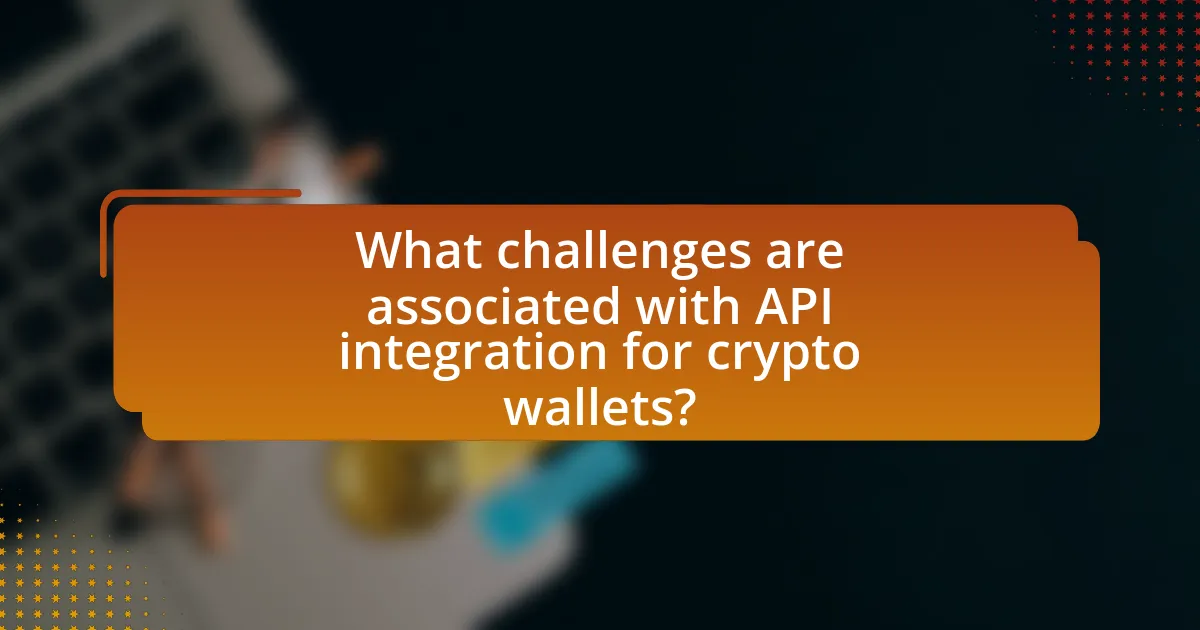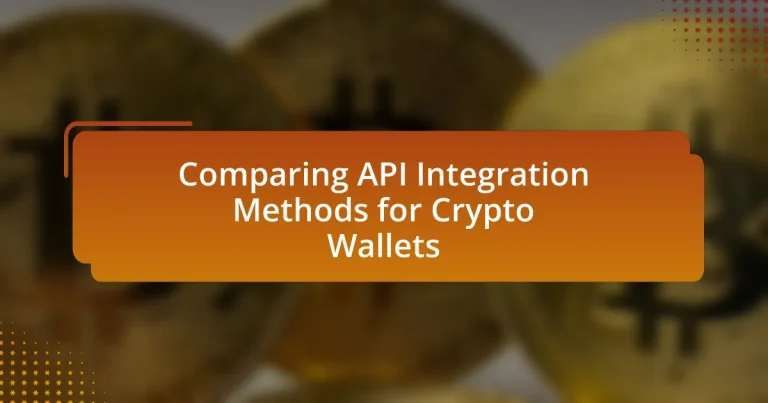The article focuses on comparing API integration methods for crypto wallets, highlighting key methods such as REST APIs, WebSocket APIs, and SDKs. It explains how these methods function to facilitate communication between wallet software and external services, detailing components like authentication, transaction management, and security protocols. The article also addresses the advantages and challenges of API integration, including security benefits, regulatory compliance, and common issues developers face. Additionally, it outlines best practices for effective integration and explores future trends in the evolving landscape of crypto wallet APIs.

What are API Integration Methods for Crypto Wallets?
API integration methods for crypto wallets include REST APIs, WebSocket APIs, and SDKs. REST APIs allow for standard HTTP requests to interact with wallet functionalities, enabling operations like balance checks and transaction processing. WebSocket APIs provide real-time data updates, facilitating instant notifications for transactions and market changes. SDKs, or Software Development Kits, offer pre-built libraries that simplify the integration process for developers, allowing them to implement wallet functionalities more efficiently. Each method serves distinct use cases, with REST APIs being widely adopted for their simplicity, while WebSocket APIs are preferred for applications requiring real-time interaction.
How do API integration methods function in the context of crypto wallets?
API integration methods in the context of crypto wallets function by enabling seamless communication between the wallet software and external services, such as exchanges or payment processors. These methods utilize standardized protocols like REST or WebSocket to facilitate data exchange, allowing users to perform transactions, check balances, and manage assets efficiently. For instance, a wallet can use an API to retrieve real-time market data or execute trades on behalf of the user, enhancing the overall user experience. The effectiveness of these integrations is evidenced by the widespread adoption of APIs in the crypto industry, with major wallets leveraging them to provide features like multi-currency support and enhanced security measures.
What are the key components of API integration for crypto wallets?
The key components of API integration for crypto wallets include authentication, transaction management, data retrieval, and security protocols. Authentication ensures that only authorized users can access wallet functionalities, typically using methods like OAuth or API keys. Transaction management involves creating, signing, and broadcasting transactions to the blockchain, which requires precise handling of transaction data. Data retrieval allows applications to access wallet balances, transaction history, and other relevant information through API calls. Security protocols, such as encryption and secure communication channels, protect sensitive data during transmission and storage, ensuring user trust and compliance with regulations.
How do these components interact with each other?
In the context of comparing API integration methods for crypto wallets, the components interact through defined protocols and data exchange mechanisms. APIs serve as intermediaries that facilitate communication between the wallet software and external services, such as blockchain networks or payment gateways. For instance, when a user initiates a transaction, the wallet API sends a request to the blockchain API, which processes the transaction and returns a confirmation. This interaction relies on standardized data formats like JSON or XML, ensuring compatibility and efficient data transfer. Additionally, security protocols such as OAuth or SSL/TLS are employed to protect the data exchanged between these components, reinforcing the integrity of the interactions.
What types of API integration methods are available for crypto wallets?
There are several types of API integration methods available for crypto wallets, including REST APIs, WebSocket APIs, and RPC (Remote Procedure Call) APIs. REST APIs are widely used for their simplicity and statelessness, allowing developers to perform standard operations like retrieving wallet balances or sending transactions using HTTP requests. WebSocket APIs provide real-time communication, enabling instant updates on transaction statuses and market data, which is crucial for trading applications. RPC APIs allow for direct communication with the blockchain, facilitating complex operations and interactions with smart contracts. Each method serves different use cases, enhancing the functionality and user experience of crypto wallets.
What is the difference between REST and WebSocket APIs?
REST APIs are stateless, request-response communication protocols primarily used for CRUD operations, while WebSocket APIs enable full-duplex communication, allowing real-time data exchange between client and server. REST operates over HTTP, requiring a new connection for each request, which can introduce latency, whereas WebSocket maintains a persistent connection, facilitating instant data transfer without the overhead of establishing new connections. This difference is crucial for applications like crypto wallets, where real-time updates on transactions and balances are essential for user experience.
How do third-party APIs compare to proprietary APIs?
Third-party APIs generally offer greater flexibility and faster integration compared to proprietary APIs, which are often more secure but less adaptable. Third-party APIs allow developers to leverage existing functionalities and services without extensive development time, making them ideal for rapid deployment in crypto wallets. In contrast, proprietary APIs provide tailored solutions that can enhance security and performance but may require significant investment in development and maintenance. For example, a study by ProgrammableWeb indicates that third-party APIs can reduce development time by up to 50%, while proprietary APIs may offer enhanced security features that are critical for financial applications.
What are the advantages of using API integration for crypto wallets?
API integration for crypto wallets offers several advantages, including enhanced security, improved user experience, and streamlined transactions. Enhanced security is achieved through secure communication protocols that protect sensitive data during transactions. Improved user experience is facilitated by seamless interactions between wallets and exchanges, allowing users to manage their assets efficiently. Streamlined transactions reduce processing times and minimize errors, which is crucial in the fast-paced cryptocurrency market. These benefits collectively contribute to a more efficient and secure environment for managing digital assets.
How does API integration enhance user experience?
API integration enhances user experience by enabling seamless interactions between different software applications, allowing users to access multiple services through a single interface. This integration streamlines processes, reduces the need for manual data entry, and minimizes errors, leading to a more efficient and user-friendly experience. For instance, in the context of crypto wallets, API integration allows users to easily connect their wallets to various exchanges and services, facilitating real-time transactions and updates. According to a study by MuleSoft, 83% of IT leaders reported that API integration significantly improves customer satisfaction by providing faster and more reliable services.
What security benefits does API integration provide?
API integration provides enhanced security benefits such as improved authentication, data encryption, and access control. These features help protect sensitive information during transactions and interactions between systems. For instance, APIs often utilize OAuth for secure authorization, ensuring that only authenticated users can access specific resources. Additionally, data transmitted through APIs can be encrypted using protocols like HTTPS, which safeguards against eavesdropping and man-in-the-middle attacks. Furthermore, robust access control mechanisms allow organizations to define user permissions, minimizing the risk of unauthorized access to critical systems and data. These security measures collectively contribute to a more secure environment for crypto wallet operations.

What challenges are associated with API integration for crypto wallets?
API integration for crypto wallets faces several challenges, including security vulnerabilities, regulatory compliance, and interoperability issues. Security vulnerabilities arise from the need to protect sensitive user data and private keys, making it crucial to implement robust encryption and authentication methods. Regulatory compliance is challenging due to varying laws across jurisdictions, which can complicate the integration process and require constant updates to adhere to legal standards. Interoperability issues occur when different wallets and blockchain networks use incompatible protocols, hindering seamless transactions and user experience. These challenges necessitate careful planning and execution to ensure successful API integration in the crypto wallet ecosystem.
What common issues arise during API integration?
Common issues that arise during API integration include authentication errors, data format mismatches, and rate limiting. Authentication errors occur when the API credentials are incorrect or not properly configured, leading to failed requests. Data format mismatches happen when the data sent to or received from the API does not conform to the expected structure, causing processing errors. Rate limiting is imposed by APIs to control the number of requests a user can make in a given timeframe, which can lead to service interruptions if exceeded. These issues are frequently encountered in various API integrations, including those for crypto wallets, where secure and accurate data exchange is critical.
How can developers address compatibility issues?
Developers can address compatibility issues by implementing thorough testing across different platforms and environments. This involves using automated testing tools to simulate various scenarios and configurations, ensuring that the API functions correctly regardless of the user’s system. Additionally, developers should adhere to industry standards and best practices for API design, which can enhance interoperability. For instance, following RESTful principles and using widely accepted data formats like JSON can minimize compatibility problems. Furthermore, maintaining comprehensive documentation and providing versioning for APIs allows developers to manage changes effectively, reducing the risk of breaking existing integrations.
What are the risks of using outdated APIs?
Using outdated APIs poses significant risks, including security vulnerabilities, compatibility issues, and lack of support. Security vulnerabilities arise because outdated APIs may not receive necessary updates or patches, making them susceptible to attacks; for instance, the 2017 Equifax breach was partly due to outdated software components. Compatibility issues can occur when newer technologies or systems are implemented, leading to integration failures or degraded performance. Additionally, reliance on outdated APIs means that developers may encounter a lack of support from the API provider, which can hinder troubleshooting and maintenance efforts. These factors collectively jeopardize the reliability and security of applications, particularly in sensitive areas like crypto wallets.
How does regulatory compliance impact API integration for crypto wallets?
Regulatory compliance significantly impacts API integration for crypto wallets by imposing strict requirements on data handling, security measures, and user verification processes. Compliance with regulations such as the Financial Action Task Force (FATF) guidelines and the General Data Protection Regulation (GDPR) necessitates that API integrations incorporate features like Know Your Customer (KYC) protocols and transaction monitoring. For instance, a study by Chainalysis highlights that adherence to these regulations can reduce the risk of fraud and enhance user trust, which is crucial for the adoption of crypto wallets. Therefore, the integration of APIs must be designed to meet these compliance standards, ensuring that they facilitate secure and lawful transactions while protecting user data.
What regulations should developers be aware of?
Developers should be aware of regulations related to data protection, anti-money laundering (AML), and know your customer (KYC) requirements when integrating APIs for crypto wallets. Data protection regulations, such as the General Data Protection Regulation (GDPR) in Europe, mandate that developers ensure user data privacy and security. AML regulations require developers to implement measures to prevent illicit activities, while KYC regulations necessitate verifying the identities of users to comply with legal standards. These regulations are critical as non-compliance can lead to significant legal penalties and reputational damage.
How can compliance be ensured during integration?
Compliance can be ensured during integration by implementing robust regulatory frameworks and continuous monitoring mechanisms. Establishing clear guidelines that align with local and international regulations, such as Anti-Money Laundering (AML) and Know Your Customer (KYC) requirements, is essential. For instance, integrating automated compliance checks within the API can facilitate real-time monitoring of transactions, ensuring adherence to legal standards. Additionally, conducting regular audits and assessments of the integration process can help identify and rectify compliance gaps, thereby reinforcing the integrity of the system.

What best practices should be followed for API integration in crypto wallets?
Best practices for API integration in crypto wallets include ensuring robust security measures, implementing thorough error handling, and maintaining clear documentation. Security is paramount; using encryption protocols like HTTPS and OAuth for authentication protects sensitive data. Error handling should be comprehensive, allowing for graceful degradation and informative error messages to enhance user experience. Clear documentation facilitates easier integration and troubleshooting, which is essential for developers. These practices are supported by industry standards, such as the OWASP API Security Top Ten, which outlines common vulnerabilities and mitigation strategies, reinforcing the importance of security in API integrations.
How can developers optimize API performance?
Developers can optimize API performance by implementing caching strategies, which reduce the need for repeated data retrieval from the server. Caching frequently accessed data minimizes latency and decreases server load, leading to faster response times. For instance, using tools like Redis or Memcached can significantly enhance performance by storing data in memory for quick access. Additionally, optimizing API endpoints by minimizing payload size and using efficient data formats, such as JSON instead of XML, can further improve performance. According to a study by Google, reducing the size of API responses can lead to a 50% decrease in load times, demonstrating the effectiveness of these optimization techniques.
What strategies can be employed to minimize latency?
To minimize latency in API integration methods for crypto wallets, employing strategies such as optimizing network protocols, utilizing caching mechanisms, and implementing asynchronous processing is essential. Optimizing network protocols, like using HTTP/2 or WebSocket, reduces the overhead of data transmission, leading to faster response times. Caching frequently accessed data decreases the need for repeated requests to the server, significantly lowering latency. Asynchronous processing allows multiple requests to be handled simultaneously, improving overall throughput and reducing wait times for users. These strategies are supported by studies indicating that optimized protocols can reduce latency by up to 50%, while effective caching can improve response times by 70%.
How can error handling be effectively managed?
Error handling can be effectively managed by implementing structured error responses and logging mechanisms in API integrations. Structured error responses provide clear information about the nature of the error, including error codes and messages, which helps developers diagnose issues quickly. Logging mechanisms capture detailed information about errors, including timestamps and context, enabling easier troubleshooting and analysis. According to a study by the IEEE, effective error handling can reduce debugging time by up to 30%, demonstrating its importance in maintaining robust API integrations for crypto wallets.
What tools and resources are available for API integration in crypto wallets?
API integration in crypto wallets can be facilitated through various tools and resources, including SDKs, libraries, and platforms. Popular SDKs such as Web3.js and Ethers.js enable developers to interact with Ethereum-based wallets seamlessly. Additionally, wallet providers like Coinbase and Binance offer comprehensive APIs that allow for transaction management, balance retrieval, and user authentication. Furthermore, platforms like Zapier and Integromat provide automation tools that can connect crypto wallets with other applications, enhancing functionality. These resources are essential for developers looking to implement efficient and secure API integrations in crypto wallets.
Which libraries and frameworks are recommended for developers?
For developers working on crypto wallet integrations, recommended libraries and frameworks include Web3.js, Ethers.js, and BitcoinJS. Web3.js is widely used for interacting with the Ethereum blockchain, providing a comprehensive set of tools for developers. Ethers.js offers a lightweight alternative with a focus on security and simplicity, making it suitable for both beginners and experienced developers. BitcoinJS is specifically designed for Bitcoin transactions, allowing developers to create and manage Bitcoin wallets effectively. These libraries are validated by their extensive use in the crypto community and their active maintenance, ensuring they remain up-to-date with the latest blockchain developments.
What documentation should be consulted for best practices?
For best practices in comparing API integration methods for crypto wallets, developers should consult the official documentation provided by the specific wallet APIs they intend to use, such as the Bitcoin Core API documentation, Ethereum JSON-RPC documentation, and the documentation for popular wallet services like Coinbase and Binance. These documents outline integration guidelines, security protocols, and performance optimization techniques essential for effective API usage. Additionally, industry standards such as the OpenAPI Specification can provide a framework for designing and documenting APIs, ensuring consistency and interoperability across different wallet integrations.
What are the future trends in API integration for crypto wallets?
Future trends in API integration for crypto wallets include enhanced interoperability, increased security measures, and the adoption of decentralized finance (DeFi) protocols. Enhanced interoperability allows different wallets and platforms to communicate seamlessly, facilitating cross-chain transactions and improving user experience. Increased security measures, such as multi-signature authentication and biometric verification, are being implemented to protect user assets against rising cyber threats. The adoption of DeFi protocols is driving the integration of APIs that enable users to access lending, borrowing, and yield farming services directly from their wallets, reflecting a shift towards more comprehensive financial solutions within the crypto ecosystem. These trends are supported by the growing demand for user-friendly and secure crypto solutions, as evidenced by the increasing number of wallet providers incorporating advanced API functionalities.
How is the landscape of API integration evolving?
The landscape of API integration is evolving towards increased automation, enhanced security, and improved interoperability. Automation tools are streamlining the integration process, allowing developers to connect applications with minimal manual coding, which accelerates deployment times. Enhanced security measures, such as OAuth 2.0 and API gateways, are being adopted to protect sensitive data and ensure secure transactions, particularly crucial in the context of crypto wallets. Furthermore, the push for interoperability among different blockchain networks is driving the development of standardized APIs, enabling seamless communication between diverse systems. This evolution is supported by the growing demand for decentralized finance (DeFi) solutions, which require robust and flexible API integrations to facilitate transactions across various platforms.
What innovations can we expect in the coming years?
In the coming years, we can expect significant innovations in API integration methods for crypto wallets, particularly through enhanced interoperability and security features. These innovations will likely include the development of standardized protocols that facilitate seamless communication between different blockchain networks, enabling users to manage multiple cryptocurrencies within a single wallet interface. Additionally, advancements in decentralized finance (DeFi) will drive the integration of smart contracts into wallet APIs, allowing for automated transactions and improved user experiences.
For instance, the rise of cross-chain solutions, such as Polkadot and Cosmos, demonstrates the growing trend towards interoperability, which can simplify the user experience and expand the functionality of crypto wallets. Furthermore, the implementation of advanced cryptographic techniques, like zero-knowledge proofs, will enhance security by allowing transactions to be verified without revealing sensitive information. These trends indicate a clear trajectory towards more user-friendly, secure, and versatile crypto wallet solutions in the near future.
What practical tips can enhance API integration for crypto wallets?
To enhance API integration for crypto wallets, developers should prioritize thorough documentation and standardized protocols. Comprehensive documentation ensures that developers understand the API’s functionalities, endpoints, and authentication methods, which reduces integration errors. Standardized protocols, such as REST or GraphQL, facilitate smoother communication between the wallet and external services, promoting interoperability. Additionally, implementing robust error handling and logging mechanisms allows for easier troubleshooting and maintenance, as developers can quickly identify and resolve issues. Security measures, including encryption and secure key management, are essential to protect sensitive user data during API transactions. These practices collectively improve the reliability and efficiency of API integrations in crypto wallets.


